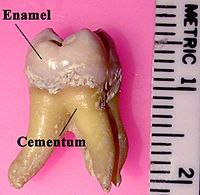
Photo from wikipedia
PURPOSE To compare the effects of gels containing 2.5% and 5% carboxymethyl chitosan amorphous calcium phosphate (CMC-ACP) on the microhardness of primary tooth enamel. METHODS Twenty-four tooth specimens were demineralized… Click to show full abstract
PURPOSE To compare the effects of gels containing 2.5% and 5% carboxymethyl chitosan amorphous calcium phosphate (CMC-ACP) on the microhardness of primary tooth enamel. METHODS Twenty-four tooth specimens were demineralized with 37% phosphoric acid and divided into four groups: an untreated control group, a positive control group treated with casein phosphopeptide amorphous calcium phosphate, and two groups treated with 2.5% and 5% CMC-ACP gel, respectively. The enamel surface hardness was then measured with a Vickers hardness tester. RESULTS In terms of Vickers Hardness Number (VHN), the degree of alteration in tooth surface microhardness was 77.83 ± 13.44 in the 5% CMC-ACP group and 52 ± 6.93 in the 2.5% CMC-ACP group (P = 0.002). The inter-group difference in the surface hardness change was significant (P < 0.05). CONCLUSION The 5% CMC-ACP gel increased the hardness of primary tooth enamel to a greater degree than the 2.5% CMC-ACP gel.
Journal Title: Journal of oral science
Year Published: 2023
Link to full text (if available)
Share on Social Media: Sign Up to like & get
recommendations!